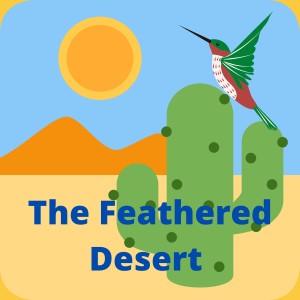
Summary: There are three categories of birds that can be found in the wild. Join Cheryl and Kiersten as they discuss the research of wildlife scientist John Marzluff and how it pertains to the birds in our backyards.
For our hearing-impaired listeners, a transcript of this podcast follows the show notes on Podbean.
Show Notes:
Welcome to Subirdia: Sharing Our Neighborhoods with Wrens, Robins, Woodpeckers, and Other Wildlife, by John Marzluff.
Transcript
Cheryl Intro:
Ever wonder who moves into the neighborhood? Birds, as adaptable as they are do not always want to live with humans, nor do they always benefit by sharing space with humans. In the book Welcome to Subirdia, the author, John Marzluff, a professor of Wildlife Science writes about this. His team of graduate students studied urban, Subarian, and forested areas to identify and count the bird species in areas around Seattle, Washington. Let’s take a look at our region of the southwest; which birds thrive in our presence, which birds adapt to living with us, and which birds choose to stay clear of human activity.
Kiersten: Avoiders
Avoiders are those native bird species that are extinguished or decline over time as urbanization intensifies. Birds like Burrowing Owls, Green heron, Orange- crowned warblers, Scarlet Tanager, or even the Scott’s Oriole, and the Hairy Woodpecker. These birds all have varying degrees of sensitivity to human development. They move farther and farther away from it. This is true of the hairy woodpecker. It builds its nest in dead trees. What HOA allows dead trees?
Burrowing owls are susceptible to predation by people’s pets, and feral cats. So, these ground dwelling owls of our local desert are pushed farther and farther out. Some birds like the Green Heron just likes its privacy, so it has a low tolerance for our activities. Scott’s Oriole, and the Scarlet Tanager enjoy forested areas, and hunt insects. Orange-crowned Warblers enjoy riparian areas. So, we can appreciate why these birds find their choice habitats not in our backyards.
Cheryl: Exploiters
Exploiters are species that thrive in our presence, often coevolving with humans and rarely occurring where people do not exist. Birds such as the American Crow, Northern Mockingbird, Barn Swallows, Barn Owls, Mallards, Canada goose, house finches, and house wrens, house sparrows, European Starling, our beloved lovebirds, and pigeons (Rock Doves). I was surprised by some of the birds on the list. These birds move into the niches vacated by those birds who find themselves more of an avoider. A few of these birds’ humans are responsible for introducing into the urban areas they are thriving in. Each species soars in abundance as soon as clearing begins and increases over time. Most of these species are not present in forested areas in large numbers. The ability of these species to capitalize on the lawns, lakes, and nesting niches created in built environments likely explains their success.
Kiersten: Adapters
“Adapters are mostly native species that thrive on natural, young, open shrubby, and dissected habitats.” (Quote from Welcome to Subirdia,) An interesting description of our neighborhoods and backyards. Adapters find and adjust to situations in our cities, urban, or suburban areas even if the natural habitat is man made.
This is the largest group of birds, which is encouraging, but these birds decline when the areas grow too close to forested habitats, or yards become overgrown, or trees too mature. Birds like Anna’s hummingbird, White-crowned sparrow, American goldfinches, Lesser goldfinch, Song sparrows, rock wrens, Curve-billed thrasher, Killdeer, and the Yellow-rumped warbler are all birds that adapt to human changes in their habitat as long as the changes are within reason.
Kiersten: Why is this information important you ask.
It is important to know how birds are adapting or not adapting to human activity so that we may better understand how we may improve our living spaces so that we make room for birds to live, too. Birds can move from one category to another for example: a bird could be an adapter until the stresses of human activity pushes it to be an avoider, or it could move from adapter to being an exploiter, like the Northern Mockingbird it all depends on how a particular species handles what humans do to their habitats.
Cheryl: Closing
It is not surprising that birds can handle many of the challenges of living people, given that they have wings to propel them away from humans, if need be, and they are linked to dinosaurs, adding their engaging personalities, flexible behaviors, and short generation times, all these things help birds to succeed in even the toughest parts of our human-dominated world.
We are capable of applying this knowledge to our backyard living spaces, parks and recreation areas, and make the adjustments necessary to support the bird life that is present now, and to build toward greater diversity in the future.
More Episodes
 2022-07-28
2022-07-28
 400
400
 2022-07-25
2022-07-25
 10
10
 2022-07-18
2022-07-18
 12
12
 2022-07-14
2022-07-14
 88
88
 2022-07-11
2022-07-11
 13
13
 2022-06-27
2022-06-27
 7
7
 2022-06-23
2022-06-23
 42
42
 2022-06-13
2022-06-13
 9
9
 2022-06-06
2022-06-06
 12
12
 2022-05-23
2022-05-23
 10
10
 2022-05-16
2022-05-16
 10
10
 2022-05-12
2022-05-12
 34
34
 2022-05-09
2022-05-09
 8
8
 2022-04-28
2022-04-28
 44
44
 2022-04-25
2022-04-25
 7
7
 2022-04-18
2022-04-18
 10
10
 2022-04-14
2022-04-14
 36
36
 2022-04-11
2022-04-11
 15
15
 2022-04-04
2022-04-04
 11
11
 2022-03-28
2022-03-28
 10
10
Create your
podcast in
minutes
- Full-featured podcast site
- Unlimited storage and bandwidth
- Comprehensive podcast stats
- Distribute to Apple Podcasts, Spotify, and more
- Make money with your podcast
It is Free
- Privacy Policy
- Cookie Policy
- Terms of Use
- Consent Preferences
- Copyright © 2015-2024 Podbean.com





